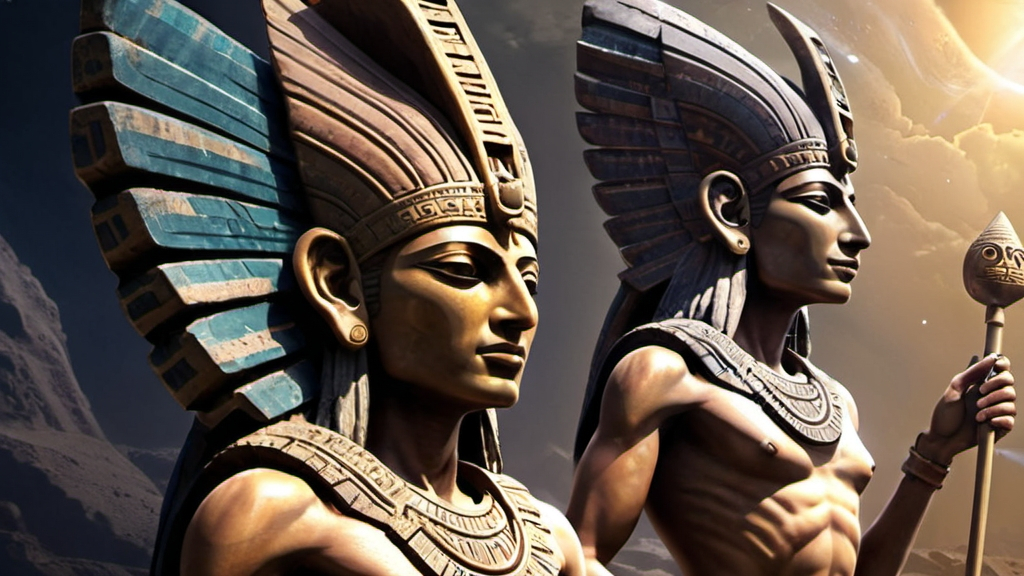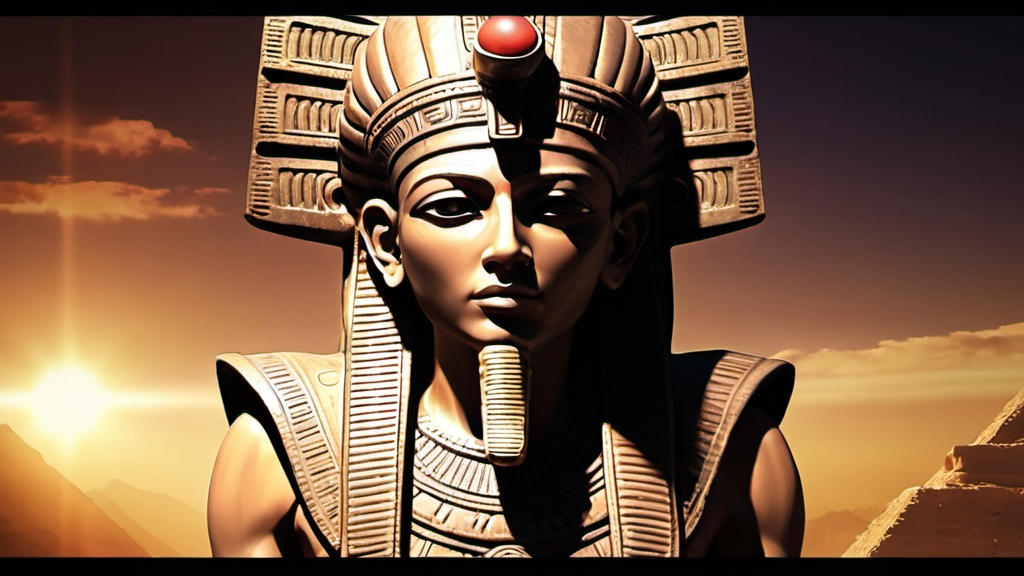Uncover Anunnaki’s Hidden Knowledge: Their Significance Today

1. Introduction
“No one really knows why the ancient Sumerians, around 4,000 years ago, decided to document on clay tablets an elaborate tale of naked extraterrestrials running to and fro and flying shiny machines. The account of the Anunnaki, which is translated as ‘those who came from the heavens’, offered the most fantastic story of gods creating mankind to be their working slave race. The Anunnaki? Where to start? Their tale is one of the most baffling and enigmatic stories ever told, but their legacy is well proven in the artifacts left behind and the impact they have made on the collective psyche of mankind. Their artifacts have left us a road map of where they have been and knowledge of what they have done. Their influence can be seen all across the planet in architectural and scientific achievements.”
1.1. What are the Anunnaki?
The Anunnaki are said to have occasionally taken the role of rulers, their first city being Eridu where Alalu was king. The city was given to Alalu’s son Anu, who was commanded by Anu to oversee the mining operation in Sumer. This supposedly is only the bottom level of vast organizations of Anunnaki. One instance where the Anunnaki rule is well documented is when Anu’s son Enki was appointed to the role of lord of Earth, with Enki’s task deemed to be the nurturing and sustaining of the world. This was very much a part-time job, and Anunnaki rule of human populations from the cities they built is also said to have varied in its levels of direction and interaction in different regions.
According to the ancient texts, the Anunnaki crossed genetically with indigenous hominid populations and attempted to create a slave race. The most ground for this can be found in the twists and inexplicable gaps in the story of human evolution with species such as Homo Erectus dying out and coming to a sudden end. The slave race they intended to create was to bear the burden of their labor, and there is even speculation today that the incarnation of the ‘New World Order’ is still serving this purpose.
The Anunnaki are the subjects of a complex of debates regarding where and when they came from, and if they are even myths at all. However, for Elliott, the Anunnaki are the subject of history, and their stories, although thousands of years old, are very much connected with the story of today. They are a race of humanoid beings that derive from Iridu, ancient Sumer, with varying depictions of where they settled and what they did around the world.
1.2. Importance of the Anunnaki’s Legacy
Primarily, the Anunnaki gave the people of the ancient world the various aspects of civilization. The Anunnaki introduced the people to the various arts and sciences, many forms of which were previously unknown to the peoples of the Earth, to raise their standard of living. Notably, the Anunnaki provided the people with written language and taught them how to use and preserve the written word. The Anunnaki also gave the people various pieces of technology and knowledge, the details of which will be addressed in subsequent sections and articles of the site. Often, the Anunnaki would jockey for position, working through the kings of the various nations or even leading the nations themselves in their bid for supremacy in the ancient world.
Many of the deities, in fact, had children by human mothers and there are many stories in the ancient texts of the acts of various half divine, half human offspring of the Anunnaki. The stories of the tragic love of Inanna, granddaughter of the sky god Enlil, and the shepherd Dumuzi are but one example of how the acts of the Anunnaki had a profound effect on the people of ancient Sumer.
An important point to realize is that the Anunnaki were not a unified group of deities as the later Greek gods were, who had little direct interaction with humans. The Anunnaki were a bickering, competitive, and violent group of gods and goddesses, frequently engaged in wars with one another, and the people of the ancient world were the unfortunate pawns in their deadly games. Not all Anunnaki were malevolent towards humans; there were many who did a great deal to help and protect humanity. The ancient stories of the Anunnaki are clear that there were both good and bad deities involved in the complex, and often deceptive, intertwining of their fates with humanity.
What cultural and historical legacy did the Anunnaki leave for the peoples of Earth? The Sumerians and later peoples living in the land of the two great rivers, the Tigris and Euphrates, had frequent contact with the Anunnaki deities. However, the details of their relationship with the Anunnaki are still not entirely clear. The question of what the Anunnaki did for the people of Earth is often asked and answered in a very general sense. It can be said with confidence that the Anunnaki left a profound and lasting legacy on the people of the Earth.
2. The Anunnaki’s Influence on Ancient Civilizations
Consider the cuneiform texts, the cultures that began in the Near East. Sumer developed into a complex civilization, lasting for over three thousand years and having lasting influences on the Eastern and Western worlds. One of the Sumerian beliefs was that life began when the gods, after creating heaven and earth, created the first city, Eridu, and the first king, Alulim. This belief was recorded on the Sumerian Kings List. This is somewhat reminiscent of Genesis 2:4-9 which records life beginning in the Garden of Eden, though there are striking differences in theology.
The story of the Anunnaki is prevalent in Sumerian mythology. They were a pantheon of deities who were the children of the sky god Anu and his sister Ki, a goddess of earth. From various inscriptions, it is evident that the kings of Sumer were to a certain extent seen as intermediaries between the gods and humankind. This is similar to the role of the Egyptian Pharaohs who were believed to be the descendants of the gods and who held a very high status in society as a result. At the same time, the Anunnaki were generally attributed with overshadowing the human race by their perfection.
This was attributed to the fact that they were to direct the natural and moral laws of mankind. The Anunnaki themselves were given very similar responsibilities to the gods of mythologies from various cultures. In this respect, it was thought by the Sumerians that the king was to be guardian, protector and the preserver of the teachings and the wisdom of the Anunnaki, in the same way that the pharaoh was seen as the very personification of the gods Horus and Osiris.
2.1. Anunnaki’s role in Mesopotamian culture
The Epic of Creation is a Mesopotamian account of the creation of the After Egypt. After Anunnaki were assigned to their decree, they became burdened with servicing the needs of humans. This was viewed as insufferable to themselves, and so they revolted. The story accounts for the result of their absence and explains the struggle faced by humanity in a concise and a little bit exciting altered version of what is being translated in the present.
Anunnakis are believed to be the founders of Mesopotamian culture. The giants are said to have been their fastest architects. The mythological me’s, their associations with the norms of creation and kingship capability, are recorded in ancient inscriptions. According to Mesopotamian texts, the scholar god intended to give man the cultural mission in the blessing of kingship. Although Anunnaki’s power overwhelmed man, a Posidim, an unknown act of aggression caused Anunnaki to lose their power of Olam (yet to be defined). The Anunnaki must answer with the view that they are responsible for humanity’s misfortunes.
2.2. Anunnaki’s impact on Egyptian civilization
Along with Mesopotamian culture, the Anunnaki giants also had an impact in ancient Egypt. This has been mentioned in many sources. According to Ra, the Anunnaki were released after being imprisoned in the Abyss because they revolted against the higher gods. A small minority of Anunnaki, as well as other higher beings and the giant king’s heir, chose not to return to the Battle of Kings.
They knew that the children of these giants were to be targeted in future genocidal acts by the lesser gods, and so the rebels took the royal offspring to a secret location in the Egyptian desert where they could be protected, according to the apocryphal Second Book of Enoch. This location was accompanied by the building of a vast spaceport and a ship-building facility run on megalithic technology. In a future act of desperation, the rebel group tried to create a clone of the deceased Thoth’s soul through an alchemical process so that they might use this clone’s advanced knowledge and spiritual mastery to counter the dark intentions of the lesser gods.
This point of history is kindred to the biblical story of the Nephilim and their technological impetus, as well as the creation of a hybridized angel/human clone known as Goliath, all of which are subsequent topics. Another ancient record of the Anunnaki giants is the history of Thoth who is credited in the history of ancient Egypt as being responsible for the knowledge and technology of the gods, which was said to be preserved during the time of the great flood. The timeline of the helping of mankind by Thoth is not entirely known, but many theorize it was the same time as the Anunnaki who were preparing for their second exodus from Earth.
During the building of his alchemical clone and looking to positively influence the ancestry of Earth humans, Thoth was a figure bridging on behalf of the rebels and is perhaps the most important figure to the secret history of mankind. He was responsible not only for preserving the Anunnaki hybrid human lineage but also for helping the rebel group to be successful in the clone creation and later persuading the Anunnaki to give anoint his hybrid ancestors with the divine right of kings to rule over post-deluvial humanity.
In his last act upon being given the Kingship knowledge, Thoth recorded the account of ancient history for his hybrid descendants who later scribed the account into The Lost Book of Enki, as part of a deal with the Anunnaki to ensure the continuity of the K Information and knowledge of this cryptic series of events has come from various archaeological artifacts, ancient texts, inscriptions, and art, making it one of the most important and impactful pieces of ancient human history.
Today, modern science is taking the preservation and secret knowledge of the Anunnaki to the highest degree, with international archaeological missions, decoding of ancient languages, DNA sciences, and genetic engineering ambitions. The Anunnaki is being brought forth into the world of mainstream science as a reality of the human species’ beginnings, and the influence of this singular race is more impactful today than any other single cross-section of human history.
2.3. Anunnaki’s connection to other ancient societies
Sargas, a right-hand man of Enlil, had incited the Anunnaki to decide on employing the more Sanskrit-looking human race as squatting servants that were probably expected to do the construction of a canal route from the Persian Gulf to the spaceport which crossed the aforementioned area of Senkland and was a crucial piece of the lower Anunnaki orbital transportation system. Sargas was forcefully stunted by Enlil’s sister Ninmah (the genetic engineering specialist for the Anunnaki human race) who was against using the indentured human workforce.
Investigation of such stages of human headway requires one to focus on the goals of the Anunnaki at that time. They intended to build a spaceport in Sippar, Mesopotamia which served as a center for transportation of goods and people between Earth and the Anunnaki’s planet Nibiru. This was partially completed in the times of the Sumerian King Sargon the Great who stated that he was guided by the eyes of his lords. Anunnaki sights and stages remain have been found in two main sites: the Harrapan remnants south of Sippar and Senkland which are the Annunaki’s point of arrival in Earth’s orbital ring and are a regression from a provoking mission at odds with Enlil.
It is factual that other ancient remnants take note of the Anunnaki, which is not astonishing. The appearance of the Anunnaki over 6000 years back staggered human headway like never before. An industrially unrefined society had jumped forward light years under the Anunnakis’ watchful eyes. They made us in their own image, participated with human females and sent the first human pioneers to wander the Earth to announce their sovereignty. Prominently, the rule of Nimrod represents a splendid time in ancient times where mankind had come full circle a long way beyond the advance of progress. The Annunaki gave the different ancient human civilizations divine command (and easy chair pioneer status) which changed the social headway of humankind.

3. Unraveling the Mysteries of the Anunnaki
The Anunnaki, one of the most important and active groups of deities in ancient Mesopotamia, are of extreme interest to anthropologists, historians, and theologians alike. These gods were believed to be the first known ancient deities recognized by ancient scholars, thus their influence on the ancient Sumerian’s religion is of importance not only for the students of history, but for those seeking to understand the cradle of civilization. The Anunnaki are believed to be the Sumerian version of the Twelve Olympians in Greece, the Dii Consentes of ancient Rome, or the Ennead of Egypt, so their importance is very high.
Because their stories and influence on the Sumerian people can be found in the literary and archaeological remains of the Sumerians, these mysterious gods are of extreme interest to those involved in the field of archaeology. Much evidence of the Anunnaki can be found due to the vast amount of written records left by the Sumerians. This can be seen in what is the most famous written record of the Anunnaki, the Babylonian creation myth, Enuma Elish. This and other stories regarding these gods and their interactions with humans provide a very detailed account of the Anunnaki’s influence and interactions with the ancient Sumerians.
This draws a contrast to the minor evidence and knowledge of other groups of gods from various other ancient civilizations. With the more recent spate of UFO and Ancient Astronaut speculation, it is this evidence of the Anunnaki’s influence and interaction with ancient man which has led to the speculation of the Anunnaki as extraterrestrial gods and the offering of controversial new theories regarding the true origin and purpose of these gods.
3.1. Ancient texts and artifacts related to the Anunnaki
The cylinder seals are a complex storyboard of events which were very important to the ancient Sumerians. It was a way for them to record their history in a form that could not be erased because the events would be verified by the Gods. What makes these seals so important is that it has been recorded that the Sumerians received knowledge of how to create the seals directly from the Anunnaki. This comes from the story of the great flood which was decreed to destroy all of mankind. One Anunnaki, Enki, who felt compassion for the man that he created, went behind the backs of the Seven Judges and secretly informed a man named Utnapishtim to construct a submersible ship.
Enki then relayed the story to a wall of the man’s house. The story was later discovered by another Anunnaki, and the judges decreed that the other Gods had to witness a great flood to determine if it was an adequate way to eliminate mankind. Utnapishtim, having already witnessed the event taking place, boarded the ship and cast it adrift. After the flood had destroyed mankind, the Anunnaki came back down to earth and discovered the destruction. It was then that they saw the error in their decision and the violation of Enki who had failed to decree the fates of mankind.
The origin of the Anunnaki is one of the most intriguing questions that attempts to unlock their real identity. This question may well be answered by the types of artifacts and the texts that are discovered. The Anunnaki have left textual evidence spanning at least a few thousand years. The first piece of information comes from an ancient Sumerian text that states: “The Anunnaki, the Seven Judges, who decree the fates of mankind.” This is a very powerful statement because it implies that the Anunnaki were not dictating our fates, but merely decreeing them similar to a judge. This gives us the indication that the Anunnaki’s influence was not as great as some theorists would have us believe. Also prevalent are hundreds of cylinder seals.
3.2. Theories and speculations about the Anunnaki’s origins
While on Earth, the religious text known as the Atrahasis is not the only source of Anunnaki speculation. Anunnaki reports have come from all over our globe in the last 100 years. From the discovery and translation of the Anuma Elish, to the many reports and findings of various texts and artifacts all over the world. What is most interesting and most significant is that all of these lost translations and new discoveries, made independent of each other by different people at different times, all pretty much say the same thing. This duplicate translation by different historians and different countries is called scholarly translation and is the most accurate form of translation. We now have a clear and detailed understanding of who they were and how they got here.
The more scientific evidence there is to support the Anunnaki theory, the more research and more data that is collected, the more opinions will shift. I used to think that the theories were bunk and that the ancient civilization on Earth was not significant enough to warrant such an advanced group to come down and help them. But after seeing all the data, all the stories, all the culture and all of the art which points to some otherworldly understanding, I have to say that it is quite hard to deny the probabilities of what is possible.
Sitchin proposes some more theories like the gravity of Nibiru, the oddness of the shapes used to describe the Anunnaki, the use of the word ‘face’ to denote the part of the body with which the masks were fitted, the use of the word ‘horde’ to describe the disastrous effect of the event on humanity, and many other speculations. For detailed versions of different theories and speculation on the origins of the Anunnaki, you can find out all relevant information.
3.3. Anunnaki’s involvement in human evolution
Myths were recorded in several Sumerian tablets. These tablets have been found by modern archaeologists, and they do not tell of man’s history, but of the history of the gods. It has long been thought by scholars in the field of mythology that myths are distorted history. This is due to man’s need to remember the past and explain how he arrived at his present state. With the work of modern archaeology and anthropology to find man’s origin, we now have a clear understanding, and with that, we can now unravel the complex tapestry of mythology. The Anunnaki are an extremely good example of how by comparing man’s application of logic and science, we can follow the same steps of the ancients and, in turn, make it possible to pull the past into the present.
It is apparent that mythology plays an essential role in our understanding. Humans, since the beginning of their consciousness, have always tried to record their presence in the universe. This has been done either by means of oral tradition that eventually became transmitted through the written word, arts such as pictures and sculptures, deeds that often became monumentalized, and more recently, by the work of modern scientific advance. Each method has its own way of telling the same history, and although the people, places, events, and times often differ, the connection between them all is miraculously intertwined.
According to the modern interpretation of myths, the Anunnaki are ETs who came from an advanced civilization or planet. The Anunnaki are the Deus, something that is proven through the work of Zecharia Sitchin, an author who has spent his entire life researching the Sumerians and using their own mythology, texts, and artifacts to present the Anunnaki as a group of ancient astronauts who over the years have become the gods we know from pantheons echoed in several ancient cultures.
4. Relevance of the Anunnaki’s Legacy Today
Depending on who you ask, the Anunnaki are either deities or overlords, beings who came to Earth to oversee slaves they had created in their own image. But of particular interest are the descriptions that can be found in the various ancient texts as they were unlike anything previously unearthed. The Anunnaki were described as tall beings with long lifespans and were markedly advanced in their knowledge of both science and spirituality.
According to some accounts, they had even engineered the first humans as slave workers to help them mine for natural resources. Due to the disparity between these stories and those found in the book of Genesis, the text of the Enuma Elish has since become of common interest to practitioners of alternative religions, such as Thelema and modern Satanism, who view it as a genuinely older and truer version of respective holy books. Around the same time as the Chaldean translation, British archaeologists were uncovering evidence of an ancient Iraq and a people wholly unknown to the West, and the combination of these new findings and the translations from Egypt generated an excitement surrounding the topic of the Anunnaki that has not since regressed.
This excitement has reached something of a crescendo in recent years, particularly among those of the New Age spiritual movement who have taken a great interest in the origins of humanity and in civilizations that are believed to have possessed advanced knowledge and technology. All this interest has generated a spectrum of new literature addressing the topic, although much of it incorporates New Age concepts and pseudohistory which has served to only confuse the topic even further.
4.1. Modern interpretations and beliefs about the Anunnaki
Many who delve into the world of the Anunnaki are overall interested in learning how this ancient civilization relates to the world around them – in particular, on the topic of religion and spirituality. Modern interpretation of the Anunnaki off of the ancient texts of Sumerians and the work of many authors has led to a new look into how humanity views its own physical and social evolution, as well as our place in the universe.
These stories would involve the creation of mankind and a biological evolution that would manipulate Homo erectus genes, leading to the creation of mankind as a servant race to the ‘gods’. These ‘gods’ would be responsible for the teaching of early man, as well as the building of civilization, taking place primarily in the areas of Sumer and the Indus Valley. These stories share striking similarity to the theory of evolution, including the biogenetic manipulation, and the teaching of early man. Because of this, many theories have since popped up surrounding the possibility that early man and the course of human evolution was really influenced by an extraterrestrial source.
This has led to new age spiritual movements and even ‘cults’ that identify the Anunnaki as being our true creators, and seek to further understand and adapt the ways of our ‘godly’ forefathers. This shift from the traditional religious views of our past into something that is more grounded in a feasible mythology offers an interesting way to bridge the gap between religion, evolution, and the real reason for the development of our civilization.
4.2. Anunnaki’s influence on popular culture and media
The day is finally here; it’s time to unlock the secrets of the Anunnaki. After reading the first chapter, I was worried that this book would be another example of conjecture based on conjecture. But I was soon relieved, in chapter two, to find that the author drops the speculative writings of Zecharia Sitchin and begins studying actual Sumerian texts. While I was hopeful that the aforementioned approach would be present in the rest of the book, we soon digress back to Sitchin’s writings. Regardless, the Sumerian texts presented within the book are extremely interesting.
My main criticism of this book centers on its lack of citing. While the author does a nice job of summarizing various ideas from other books and articles, there is no way for the diligent reader to follow up on the author’s sources. Having a page of citations at the end of the book would make this book immensely more valuable to the reader and serve to dissuade the oft-leveled claim that the text is a work of fiction rather than a serious exploration of a fascinating topic.
4.3. Implications of the Anunnaki’s existence on our understanding of history and spirituality
For one thing, the realization of the Anunnaki’s enigmatic influence on ancient human civilizations provides a framework which can finally explain the many otherwise confusing enigmas that pepper our historical record. Such a realization has already been used to great effect in the alternative history and ancient astronaut theories, which resolve many historical inconsistencies by using the Anunnaki story as a basis. An example is the conflicting and often illogical reasons for grandiose construction projects such as the pyramids of Egypt, which can easily be explained as the result of forced slave labor under Anunnaki supervision.
This new perspective on human history will be more fully embraced when genetic science in the near future will provide many more discoveries on the nature of humanity. These will serve to further corroborate the Anunnaki story due to close similarities found between their DNA and ours. It is only at this point that the full worldwide implications of the Anunnaki story can be truly assessed, at which time it will already have sparked a revolution in our whole outlook on human history and spirituality.
It’s certainly not a surprise that the astonishing disclosures made in previous sections have a real impact on society today. It is also to be expected that the legacy of a culture which has made so many contributions to mankind should survive and still be relevant, as is the case with the Anunnaki. What is unexpected however (to some at least), was that it took the 20th century discovery of the Anunnaki and their culture to make this happen. In some ways, it could be said that the Anunnaki have left a legacy far more lasting than they ever could have anticipated, simply by virtue of it taking us so long to figure out the truth about them.
This simply serves to illustrate the covert nature of their influence on human affairs by highlighting the desperate measures they took to remain hidden from the human populace. In any event, the world was a very different place when the Anunnaki were still amongst us, and when this is realized by the implications drawn from their rediscovery, it becomes abundantly clear what a lasting impact they have had on the course of human history.
References:
Жиглов, В “Mistake of Gods.” 2023. [HTML]
Hammer, O. and Swartz, K. “Ancient Aliens.” Handbook of UFO Religions, 2021. [HTML]
Rayhan, A. “A Brief History of Humankind Exploring the Alien Hypothesis.” researchgate.net, . researchgate.net
EMERSON, RALPH WALDO. “Nibiru and Armageddon.” The Anunnaki Connection: Sumerian Gods, Alien DNA, and the Fate of Humanity (From Eden to Armageddon) (2020): 195. [HTML]
Uusimäki, E. “Ancient Travellers, Intercultural Contact, and the Fear of Gods.” Religions, 2024. mdpi.com
Verderame, Lorenzo, and Agnes Garcia-Ventura. “Receptions of the Ancient Near East in popular culture and beyond.” Receptions of the Ancient Near East in Popular Culture and Beyond (2020): 1-332. [HTML]
Adetiloye, P. O. “HOW AND WHY WE CAME FROM PLANET MARS TO PLANET EARTH.” 2024. [HTML]
Emelianov, Vladimir V. “TEMPORAL PERCEPTION IN ANCIENT MESOPOTAMIA.” Temporal Concepts and Perception of Time in the Ancient Orient. (2021): 15. academia.edu
Buike, B. “Principles of Power at start of 21st Century.” 2024. hcommons.org
Romney, N. Sumerian Origins: Lifting the Veil on Ancient Mesopotamian Mysteries.” 2020. [HTML]








Connect me